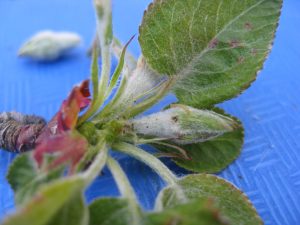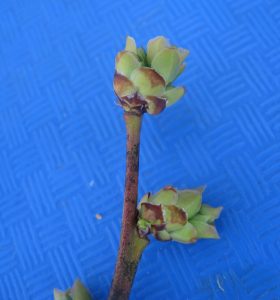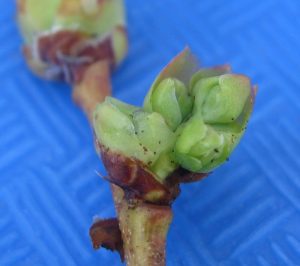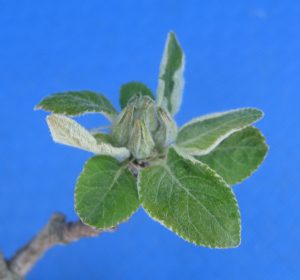May 2nd winter moth update
May 2, 2018 winter moth update
Winter moth eggs have finished hatching and I’ve been checking for winter moth caterpillars around Rhode Island. I’m finding very few caterpillars! Winter moths can be found throughout RI, but the only place I’ve seen winter moth caterpillars in high numbers is in abandoned apple orchards that haven’t been sprayed in years. Even unsprayed blueberry plants have many fewer winter moth caterpillars compared to past years. All landscape trees I’ve checked have very few caterpillars – so I don’t think any landscape trees require insecticide applications this year.
Check apple and blueberry flower buds now to see if an insecticide spray is warranted to protect your crop. You will probably need a magnifying glass. Best Management Practices for Nova Scotia Apple Production manual recommends an insecticide application when more than 10% of flower buds contain winter moth caterpillars. Now is a perfect time to scout apple and blueberry flower buds. Caterpillars are still small and difficult to see, so it is easiest to find evidence of caterpillars by looking for “frass” – insect poop.
If you find more than 10% of flower buds with winter moth frass or caterpillars, consider applying an insecticide such as Bt (DiPel, Thuricide), spinosad (Delegate, Captain Jack’s Deadbug Brew, Entrust), or other another insecticide such as Imidan or Malathion. Bt (Bacillus thuringiensis) insecticides is an excellent choice because it kills only caterpillars and is not harmful to bees. URI’s orchard was sprayed with Bt on Sunday and winter moth control has been excellent.
Blueberry flower buds. Can’t see winter moth caterpillars inside without pulling bud apart.
Once blueberry bud is pulled apart black-brown frass is visible. Best to use a magnifying glass.
Apple flower bud at Tight Cluster bud stage. Can’t see if winter moth caterpillars are inside.

Apple flower bud pulled apart revealing winter moth caterpillar and frass between individual buds.
 Home
Home Browse
Browse Close
Close Events
Events Maps
Maps Email
Email Brightspace
Brightspace eCampus
eCampus





